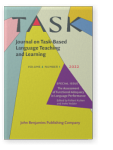Functional adequacy, task-based language teaching and instructed second language acquisition
A commentary
This commentary synthesizes the five articles in Kuiken and Vedder’s special issue on functional adequacy in
linguistic performance. The commentary considers the different scales that were used to measure functional adequacy, as well as
the relationship between functional adequacy and other measures of linguistic performance such as complexity, accuracy, and
fluency. The commentary also considers how functional adequacy might be usefully incorporated more frequently into studies from a
task-based language teaching or instructed second language acquisition perspective, both as pedagogical instruction and as a means
of measuring linguistic development.
References (10)
References
Council of Europe. (2001). Commonm European Framework of Reference for Languages: Learning, teaching, assessment. Council of Europe.
Kuiken, F., & Vedder, I. (2017). Functional
adequacy in L2 writing. Towards a new rating scale. Language
Testing, 34(3), 321–336. 

Kuiken, F., Vedder, I., & Gilabert, R. (2010). Communicative
adequacy and linguistic complexity in L2 writing. In I. Bartning, M. Martin & I. Vedder (Eds.) Communicative
proficiency and linguistic development: Intersections between SLA and language testing
research (pp. 81–100). Eurosla
Monographs Series
1. Roma: Eurosla.
Loewen, S. (2020). Introduction
to instructed second language acquisition (2nd
ed.). Routledge. 

Loewen, S., & Wolff, D. (2016). Peer
interaction in F2F and CMC contexts. In M. Sato & S. Ballinger (Eds.), Peer
interaction and second language learning: Pedagogical potential and research
agenda (pp. 163–184). John Benjamins. 

Marsden, E., Morgan-Short, K., Thompson, S., & Abugaber, D. (2018). Replication
in second language research: Narrative and systematic reviews and recommendations for the field: replication in second
language research. Language
Learning,
68
(2), 321–391. 

Michel, M. (2017). Complexity,
accuracy, and fluency in L2 production. In S. Loewen & M. Sato (Eds.), The Routledge handbook of instructed second language acquisition (pp. 50–68). Routledge. 

Révész, A., Ekiert, M., & Torgersen, E. (2016). The
effects of complexity, accuracy and fluency on communicative adequacy in oral task
performance. Applied
Linguistics,
37
(6), 828–848. 

Cited by (2)
Cited by two other publications
Wei, Ran & Xiaoyan Zhao
2024.
Effects of task-based language teaching on functional adequacy in L2 writing.
Assessing Writing 60
► pp. 100838 ff.

Kuiken, Folkert & Ineke Vedder
This list is based on CrossRef data as of 5 july 2024. Please note that it may not be complete. Sources presented here have been supplied by the respective publishers.
Any errors therein should be reported to them.
